Ore-Fluid Evolution of the Sizhuang Orogenic Gold Deposit, Jiaodong Peninsula, China
Abstract
1. Introduction
2. Geological Background
2.1. Regional Geology
2.2. Deposit Geology
3. Sampling and Analytical Procedures
4. Results
4.1. Fluid Inclusion Petrography
4.2. Microthermometry of Fluid Inclusions
4.2.1. Early Stage
4.2.2. Main Stage
4.2.3. Late Stage
4.2.4. Salinity and Density
5. Discussion
5.1. Fluid Immiscibility and Pressure Fluctuation
5.2. Source and Evolution of Ore-Fluid
5.2.1. Source of Ore-Fluid
5.2.2. Fluid Evolution and Water–Rock Interaction
6. Conclusions
- Microthermometry showed less obvious differences between different mineralization styles, which suggested a similar mechanism of gold deposition.
- The ore-forming fluid was in a medium-high temperature (210–368 °C), medium-low salinity (4.14–11.83 wt% NaCl eq.) and low density (0.516–1.02 g/cm3) CO2–H2O–NaCl system. The peak of ThTOT during mineralization appeared in 270–300 °C.
- The fluid immiscibility caused by pressure fluctuation at the main stage was the key mechanism of gold mineralization in the Sizhuang gold deposit.
- The source of ore-forming fluid in the metallogenic early stage was mainly the original metamorphic water of Jiaodong group. In main stage, the mixing fluid of the original metamorphic water of Jiaodong group and meteoric water in mixing ranged between 4:1 to 2:1 was most conducive to mineralization.
Supplementary Materials
Author Contributions
Funding
Acknowledgments
Conflicts of Interest
References
- Yang, L.Q.; Deng, J.; Wang, Z.L.; Zhang, L.; Guo, L.N.; Song, M.C.; Zheng, X.L. Mesozoic gold metallogenic system of the Jiaodong gold province, eastern China. Acta Petrol. Sin. 2014, 30, 2447–2467, (In Chinese with English abstract). [Google Scholar]
- Deng, J.; Yang, L.Q.; Li, R.H.; Groves, D.I.; Santosh, M.; Wang, Z.L.; Sai, S.X.; Wang, S.R. Regional structural control on the distribution of world-class gold deposits: An overview from the giant Jiaodong Gold Province, China. Geol. J. 2018, 54, 378–391. [Google Scholar] [CrossRef]
- Deng, J.; Liu, X.F.; Wang, Q.F.; Dilek, Y.; Liang, Y.Y. Isotopic characterization and petrogenetic modeling of Early Cretaceous mafic diking–Lithospheric extension in the North China craton, eastern Asia. Geol. Soc. Am. Bull. 2017, 129, 1379–1407. [Google Scholar] [CrossRef]
- Zhang, L.; Yang, L.Q.; Weinberg, R.F.; Groves, D.I.; Wang, Z.L.; Li, G.W.; Liu, Y.; Zhang, C.; Wang, Z.K. Anatomy of a world-class epizonal orogenic-gold system: A holistic thermochronological analysis of the Xincheng gold deposit, Jiaodong Peninsula, eastern China. Gondwana Res. 2019, in press. [Google Scholar] [CrossRef]
- Deng, J.; Wang, C.M.; Bagas, L.; Carranza, E.J.M.; Lu, Y.J. Cretaceous–Cenozoic tectonic history of the Jiaojia Fault and gold mineralization in the Jiaodong Peninsula, China: Constraints from zircon U–Pb, illite K–Ar, and apatite fission track thermochronometry. Mineral. Depos. 2015, 50, 987–1006. [Google Scholar] [CrossRef]
- Yang, L.Q.; Deng, J.; Guo, L.N.; Wang, Z.L.; Li, X.Z.; Li, J.L. Origin and evolution of ore fluid, and gold deposition processes at the giant Taishang gold deposit, Jiaodong Peninsula, eastern China. Ore Geol. Rev. 2016, 72, 585–602. [Google Scholar] [CrossRef]
- Goldfarb, R.J.; Santosh, M. The dilemma of the Jiaodong gold deposits: Are they unique? Geosci. Front. 2014, 5, 139–153. [Google Scholar] [CrossRef]
- Deng, J.; Wang, Q.F. Gold mineralization in China: Metallogenic provinces, deposit types and tectonic framework. Gondwana Res. 2016, 36, 219–274. [Google Scholar] [CrossRef]
- Wang, Z.L.; Yang, L.Q.; Guo, L.N.; Marsh, E.; Wang, J.P.; Liu, Y.; Zhang, C.; Li, R.H.; Zhang, L.; Zheng, X.L.; Zhao, R.X. Fluid immiscibility and gold deposition in the Xincheng deposit, Jiaodong Peninsula, China: A fluid inclusion study. Ore Geol. Rev. 2015, 65, 701–717. [Google Scholar] [CrossRef]
- Guo, L.N.; Goldfarb, R.J.; Wang, Z.L.; Li, R.H.; Chen, B.H.; Li, J.L. A comparison of Jiaojia- and Linglong-type gold deposit ore-forming fluids: Do they differ? Ore Geol. Rev. 2017, 88, 511–533. [Google Scholar] [CrossRef]
- Yang, L.Q.; Deng, J.; Zhang, J.; Wang, Q.F.; Gao, B.F.; Zhou, Y.H.; Guo, C.Y.; Jiang, S.Q. Preliminary studies of fluid inclusions in Damoqnjia gold deposit along Zhaoping fault zone, Shandong province, China. Acta Petrol. Sin. 2007, 23, 153–160. [Google Scholar]
- Yang, L.Q.; Deng, J.; Zhang, J.; Guo, C.Y.; Gao, B.F.; Gong, Q.J.; Wang, Q.F.; Jiang, S.Q.; Yu, H.J. Decrepitation thermometry and compositions of fluid inclusions of the Damoqujia Gold Deposit, Jiaodong Gold Province, China: Implications for metallogeny and exploration. J. China Univ. Geosci. 2008, 19, 378–390. [Google Scholar]
- Deng, J.; Liu, X.F.; Wang, Q.F.; Pan, R.G. Origin of the Jiaodong-type Xinli gold deposit, Jiaodong Peninsula, China: Constraints from fluid inclusion and C–D–O–S–Sr isotope compositions. Ore Geol. Rev. 2015, 65, 674–686. [Google Scholar] [CrossRef]
- Yang, L.Q.; Dilek, Y.; Wang, Z.L.; Weinberg, R.F.; Liu, Y. Late Jurassic, high Ba-Sr Linglong granites in the Jiaodong Peninsula, East China: Lower crustal melting products in the Eastern North China Craton. Geol. Mag. 2018, 155, 1040–1062. [Google Scholar] [CrossRef]
- Wang, Z.L. Metallogenic System of Jiaojia Gold Orefield, Shandong Province, China. Ph.D. Thesis, China University of Geosciences (Beijing), Beijing, China, 2012. [Google Scholar]
- Wei, Q.; Fan, H.R.; Lan, T.G.; Liu, X.; Jiang, X.H.; Wen, B.J. Genesis of Sizhuang gold deposit, Jiaodong Peninsula: Evidences from fluid inclusion and quartz solubility modeling. Acta Geol. Sin. 2015, 31, 1049–1062, (In Chinese with English abstract). [Google Scholar]
- Yang, L.Q.; Deng, J.; Wang, Z.L.; Guo, L.N.; Li, R.H.; Groves, D.I.; Danyushevskiy, L.; Zhang, C.; Zheng, X.L.; Zhao, H. Relationships between gold and pyrite at the Xincheng gold deposit, Jiaodong Peninsula, China: Implications for gold source and deposition in a brittle epizonal environment. Econ. Geol. 2016, 111, 105–126. [Google Scholar] [CrossRef]
- Jahn, B.M.; Liu, D.Y.; Wan, Y.S.; Song, B.; Wu, J.S. Archean crustal evolution of the Jiaodong Peninsula, China, as revealed by zircon shrimp Geochronology lemental and Nd-isotope Geochemistry. Am. J. Sci. 2008, 308, 232–269. [Google Scholar] [CrossRef]
- Deng, J.; Wang, Q.F.; Wan, L.; Liu, H.; Yang, L.Q.; Zhang, J. A multifractal analysis of mineralization characteristics of the Dayingezhuang disseminated-veinlet gold deposit in the Jiaodong gold province of China. Ore Geol. Rev. 2011, 40, 54–64. [Google Scholar] [CrossRef]
- Geng, Y.S.; Du, L.L.; Ren, L.G. Growth and reworking of the early Precambrian continental crust in the North China Craton: Constraints from zircon Hf isotopes. Gondwana Res. 2012, 21, 517–529. [Google Scholar] [CrossRef]
- Zhang, L.; Liu, Y.; Li, R.H.; Huang, T.; Zhang, R.Z.; Chen, B.H.; Li, J.K. Lead isotope geochemistry of Dayingezhuang gold deposit, Jiaodong Peninsula, China. Acta Petrol. Sin. 2014, 30, 2468–2480, (In Chinese with English abstract). [Google Scholar]
- Zhang, L.; Li, G.W.; Zheng, X.L.; An, P.; Chen, B.Y. 40Ar/39Ar and fission-track dating constraints on the tectonothermal history of the world-class Sanshandao gold deposit, Jiaodong Peninsula, Eastern China. Acta Petrol. Sin. 2016, 32, 2465–2476, (In Chinese with English abstract). [Google Scholar]
- Dong, C.Y.; Wang, S.J.; Liu, D.Y.; Wang, J.G.; Xie, H.Q.; Wang, W.; Song, Z.Y.; Wan, Y.S. Late palaeoproterozoic crustal evolution of the North China Craton and formation time of the Jingshan Group: Constraints from SHRIMP U-Pb zircon dating of meta-intermediate-basic intrusive rocks in eastern Shandong Province. Acta Petrol. Sin. 2010, 27, 1699–1706, (In Chinese with English abstract). [Google Scholar]
- Liu, P.H.; Liu, F.L.; Wang, F.; Liu, J.H.; Cai, J. Petrological and geochronological preliminary study of the Xiliu ~2.1 Ga meta-gabbro from the Jiaobei terrane, the southern segment of the Jiao-Liao-Ji Belt in the North China Craton. Acta Petrol. Sin. 2013, 29, 2371–2390, (In Chinese with English abstract). [Google Scholar]
- Faure, M.; Lin, W.; Monie, P.; Bruguier, O. Paleoproterozoic arc magmatism and collision in Liaodong Peninsula (north-east China). Terra Nova 2004, 16, 75–80. [Google Scholar] [CrossRef]
- Zhang, L.; Yang, L.Q.; Wang, Y.; Weinberg, R.F.; An, P.; Chen, B.Y. Thermochronologic constrains on the processes of formation and exhumation of the Xinli orogenic gold deposit, Jiaodong Peninsula, eastern China. Ore Geol. Rev. 2017, 81, 140–153. [Google Scholar] [CrossRef]
- Zhang, J.; Zhao, Z.F.; Zheng, Y.F.; Dai, M. Postcollisional magmatism: Geochemical constraints on the petrogenesis of Mesozoic granitoids in the Sulu orogen, China. Lithos 2010, 119, 512–536. [Google Scholar] [CrossRef]
- Wang, Z.L.; Yang, L.Q.; Deng, J.; Santosh, M.; Zhang, H.F.; Liu, Y.; Li, R.H.; Huang, T.; Zheng, X.L.; Zhao, H. Gold-hosting high Ba-Sr granitoids in the Xincheng gold deposit, Jiaodong Peninsula, East China: Petrogenesis and tectonic setting. J. Asian Earth Sci. 2014, 95, 274–299. [Google Scholar] [CrossRef]
- Deng, J.; Wang, C.M.; Bagas, L.; Santosh, M.; Yao, E. Crustal architecture and metallogenesis in the south-eastern North China Craton. Earth-Sci. Rev. 2018, 182, 251–272. [Google Scholar] [CrossRef]
- Jiang, N.; Chen, J.; Guo, J.; Chang, G. In situ zircon U–Pb, oxygen and hafnium isotopic compositions of Jurassic granites from the North China craton: Evidence for Triassic subduction of continental crust and subsequent metamorphism-related 18O depletion. Lithos 2012, 142, 84–94. [Google Scholar] [CrossRef]
- Brown, P.E.; Hagemann, S.G. MacFlincor and its application to fluids in Archaean lode-gold deposits. Geochim. Cosmochim. Acta 1995, 59, 3943–3952. [Google Scholar] [CrossRef]
- Anderson, M.R.; Rankin, A.H.; Spiro, B. Fluid mixing in the generation of isothermal gold mineralization in the Transvaal Sequence, Transvaal, South Africa. Eur. J. Mineral. 1992, 4, 933–948. [Google Scholar] [CrossRef]
- Bakker, R.J.; Jansen, J.B.H. A mechanism for preferential H2O leakage from fluid inclusions in quartz, based on TEM observations. Contrib. Mineral. Petrol. 1994, 116, 7–20. [Google Scholar] [CrossRef]
- Xavier, R.P.; Foster, R.P. Fluid evolution and chemical controls in the Fazenda Maria Preta (FMP) gold deposit, Rio Itapicuru greenstone belt, Bahia, Brazil. Chem. Geol. 1999, 154, 133–154. [Google Scholar] [CrossRef]
- Roedder, E. Fluid inclusions. Rev. Mineral. 1984, 12, 1–664. [Google Scholar]
- Jiang, N.; Xu, J.H.; Song, M.X. Fluid inclusion characteristics of mesothermal gold deposits in the Xiaoqinling District, Shaanxi and Henan Provinces, People’s Republic of China. Mineral. Depos. 1999, 34, 150–162. [Google Scholar]
- Oslen, S.N. High density CO2 inclusions in the Colorado Front Range. Contrib. Mineral. Petrol. 1988, 100, 226–235. [Google Scholar]
- Hollister, L.S. Enrichment of CO2 in fluid inclusions in quartz by removal of H2O during crystal–plastic deformation. J. Struct. Geol. 1990, 12, 895–901. [Google Scholar] [CrossRef]
- Sibson, Y.C.; Robert, F.; Poulsen, K.H. High angle reverse faults, fluid-pressure cycling, and mesothermal gold quartz deposits. Geology 1988, 16, 551–555. [Google Scholar] [CrossRef]
- Diamond, L.W. Fluid inclusion evidence for P–V–T–X evolution of hydrothermal solutions in late-Alpine gold–quartz veins at Brusson, Val d’Ayas, northwest Italian Alps. Am. J. Sci. 1990, 290, 912–958. [Google Scholar] [CrossRef]
- Robert, F.; Kelly, W.C. Ore-forming fluids in Archean goldbearing quartz veins at the Sigma mine, Abitibi greenstone belt, Quebec, Canada. Econ. Geol. 1987, 82, 1464–1482. [Google Scholar] [CrossRef]
- Dugdale, A.L.; Hagemann, S.G. The Bronzewing lode gold deposit, eastern Australia: P–T–X evidence for fluid immiscibility caused by cyclic decompression in gold-bearing quartz-veins. Chem. Geol. 2001, 173, 59–90. [Google Scholar] [CrossRef]
- Robert, F.; Boullier, A.M.; Firdaous, K. Gold–quartz veins in metamorphic terranes and their bearing on the role of fluids in faulting. J. Geophys. Res. 1995, 100, 12861–12879. [Google Scholar] [CrossRef]
- Qiu, K.F.; Marsh, E.; Yu, H.C.; Pfaff, K.; Gulbransen, C.; Gou, Z.Y.; Li, N. Fluid and metal sources of the Wenquan porphyry molybdenum deposit, Western Qinling, NW China. Ore Geol. Rev. 2017, 86, 459–473. [Google Scholar] [CrossRef]
- Yang, Z.F.; Xu, J.K.; Zhao, L.S.; Wu, Y.B.; Shen, Y.L. Geochemical studies of hydrogen and oxygen isotopes and ore-forming fluid compositions of fluid inclusions in quartz from two types of gold deposits in Jiaodong. Acta Mineral. Sin. 1991, 11, 365–369, (In Chinese with English abstract). [Google Scholar]
- Jiang, X.H. Fluid Evolution and Genesis of Altered Type Gold Deposits in Northwestern Jiaodong. Ph.D. Thesis, Institute of Geology and Geophysics, Chinese Academy of Sciences, Beijing, China, 2011. [Google Scholar]
- Clayton, R.N.; O’Neil, J.R.; Mayeda, T.K. Oxygen isotope exchange between quartz and water. J. Geophys. Res. 1972, 77, 3057–3067. [Google Scholar] [CrossRef]
- Suzuoki, T.; Epstein, S. Hydrogen isotope fractionation between OH-bearing minerals and water. Geochim. Cosmochim. Acta 1976, 40, 1229–1240. [Google Scholar] [CrossRef]
- Chen, Z.S.; Zhang, L.G.; Liu, J.X.; Wang, B.C.; Xu, J.F.; Zheng, W.S. A preliminary study on hydrogen and oxygen isotope geochemical backgrounds of geological bodies in Jiaodong (eastern Shandong) gold metallogenic region. Acta Petrol. Mineral. 1995, 14, 211–218, (In Chinese with English abstract). [Google Scholar]
- Lin, W.W.; Yin, X.L. Isotope geological characteristics of mineralizing fluids of gold deposits in Jiaodong area and a discussion on the application conditions of H.P. Taylor’s equation. Acta Petrol. Mineral. 1998, 17, 248–259, (In Chinese with English abstract). [Google Scholar]
- Mao, J.W.; Li, H.M.; Wang, Y.T.; Zhang, C.Q.; Wang, R.T. The relationship between mantle-derived fluid and gold ore-formation in the eastern Shandong peninsula: Evidences from D-O-C-S isotopes. Acta Geol. Sin. 2005, 79, 839–857, (In Chinese with English abstract). [Google Scholar]
- Zhang, L.G.; Chen, Z.S.; Liu, J.X.; Yu, G.X.; Wang, B.C.; Xu, J.F.; Zheng, W.S. Water-rock exchenge in the Jiaojia type gold deposit: A study of hydrogen and oxygen isotopic composition of ore-forming fluids. Mineral. Depos. 1994, 13, 193–200, (In Chinese with English abstract). [Google Scholar]
- Guo, L.N.; Zhang, C.; Song, Y.Z.; Chen, B.H.; Zhou, Z.; Zhang, B.L.; Xu, X.L.; Wang, Y.W. Hydrogen and oxygen isotopes geochemistry of the Wang’ershan gold deposit, Jiaodong. Acta Petrol. Sin. 2014, 30, 2481–2494, (In Chinese with English abstract). [Google Scholar]
- Taylor, H.P., Jr. The application of oxygen and hydrogen isotope studies to problems of hydrothermal alteration and ore deposition. Econ. Geol. 1974, 69, 843–883. [Google Scholar] [CrossRef]
- O’Neil, J.R.; Taylor, H.P., Jr. The oxygen isotope and cation exchange chemistry of feldspars. Am. Mineral. 1967, 52, 1414–1437. [Google Scholar]
- Zheng, Y.F.; Chen, J.F. Stable Isotope Geochemistry, 1st ed.; Science Press: Beijing, China, 2000; pp. 177–182. [Google Scholar]
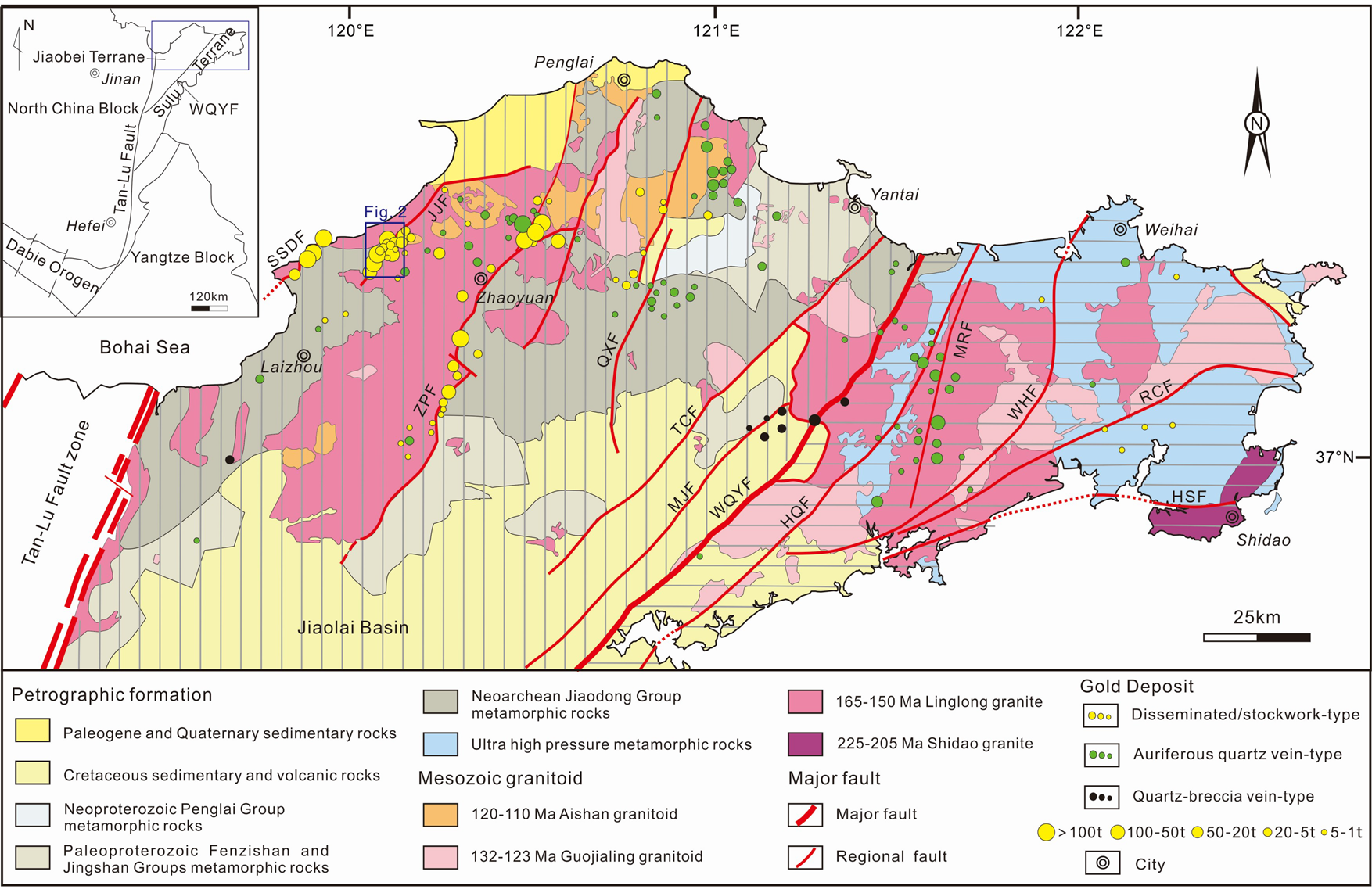
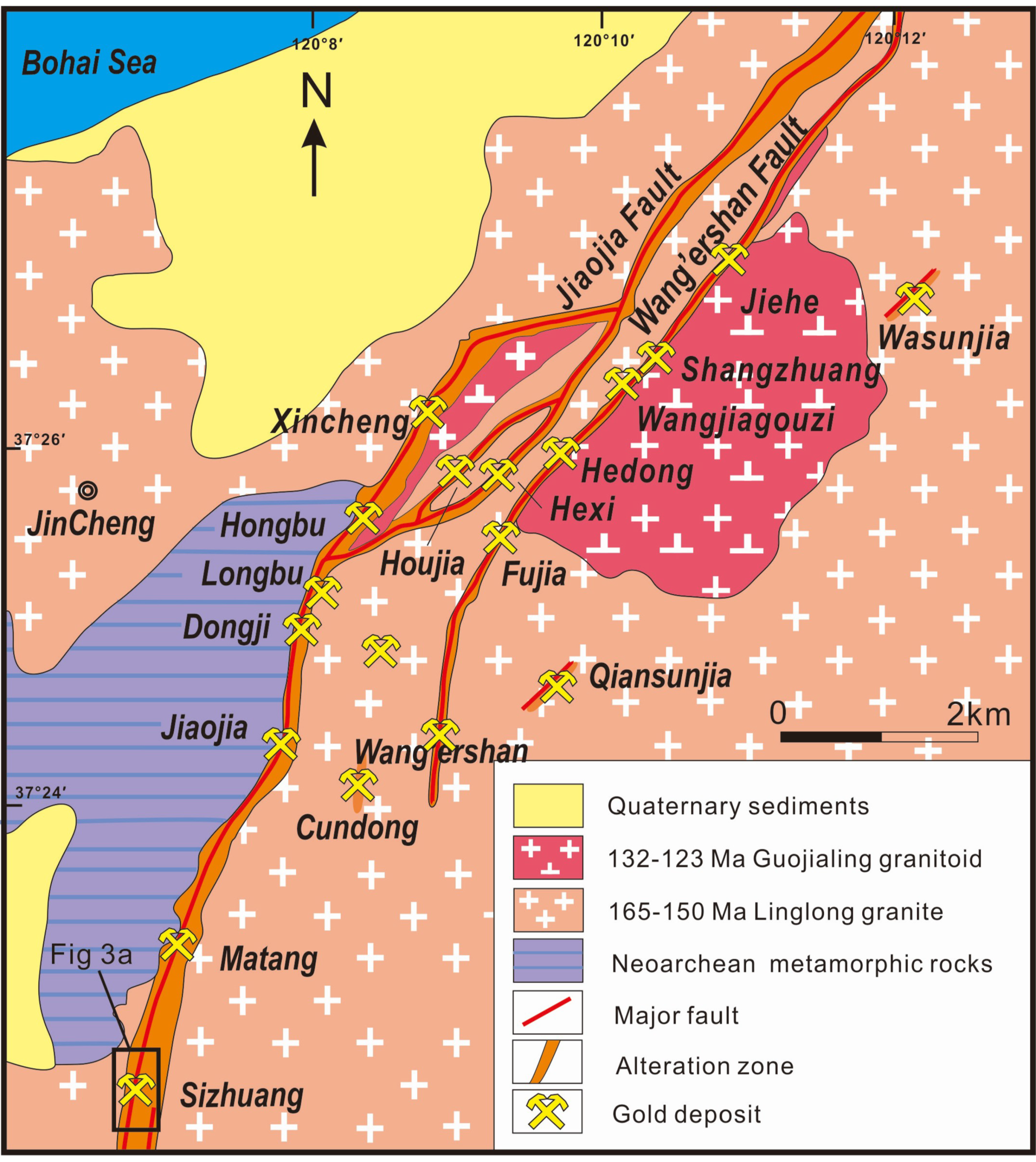
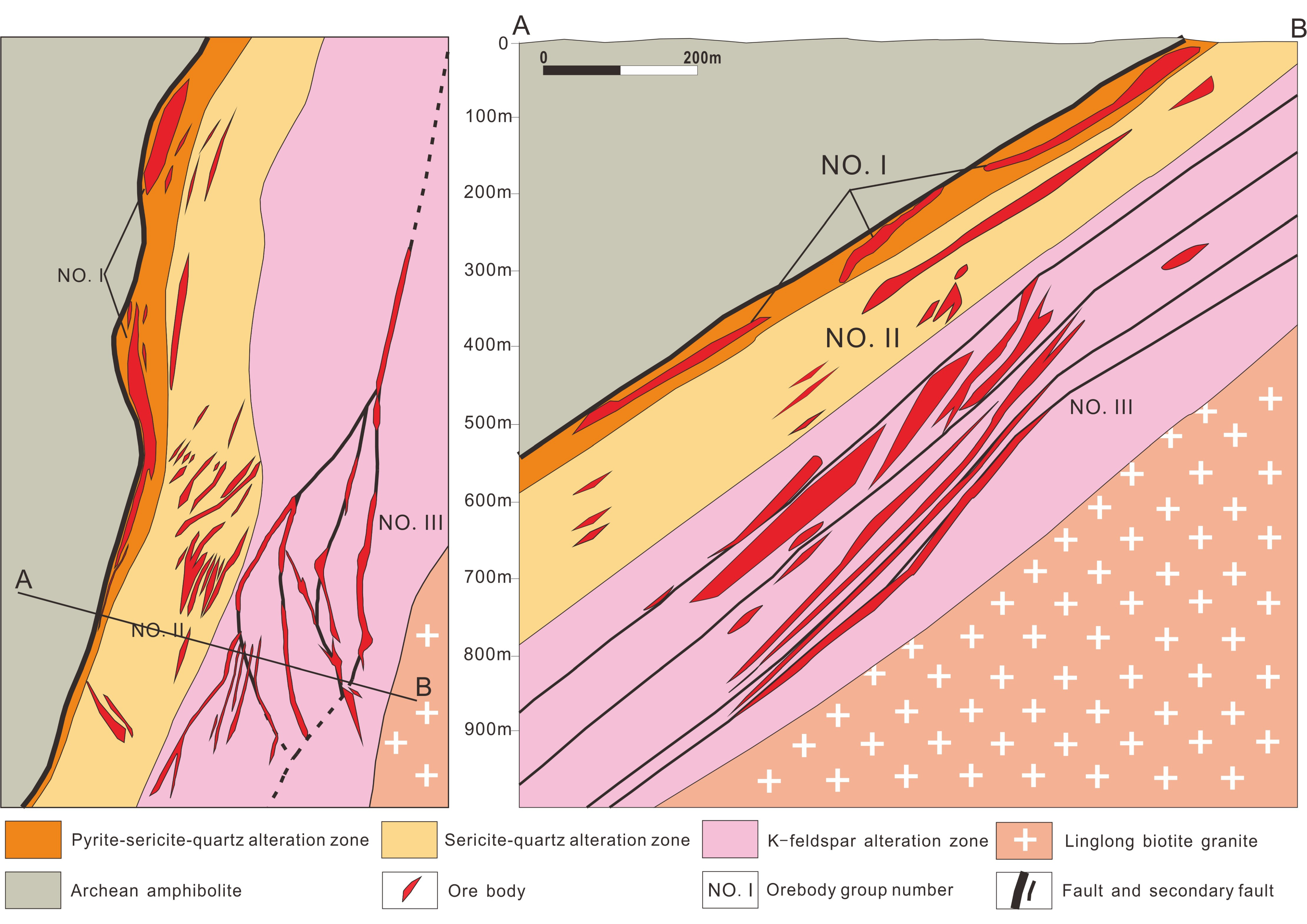
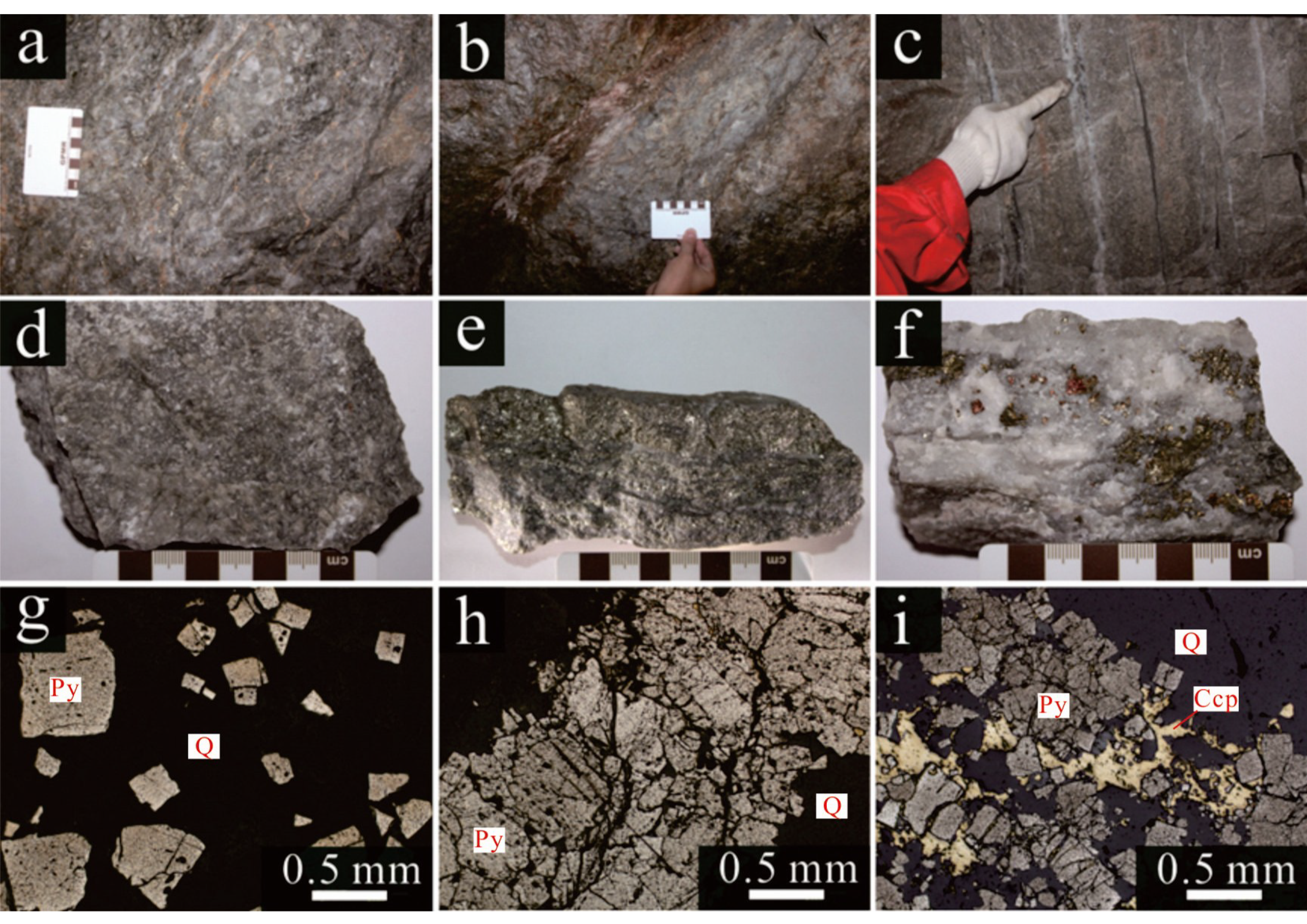
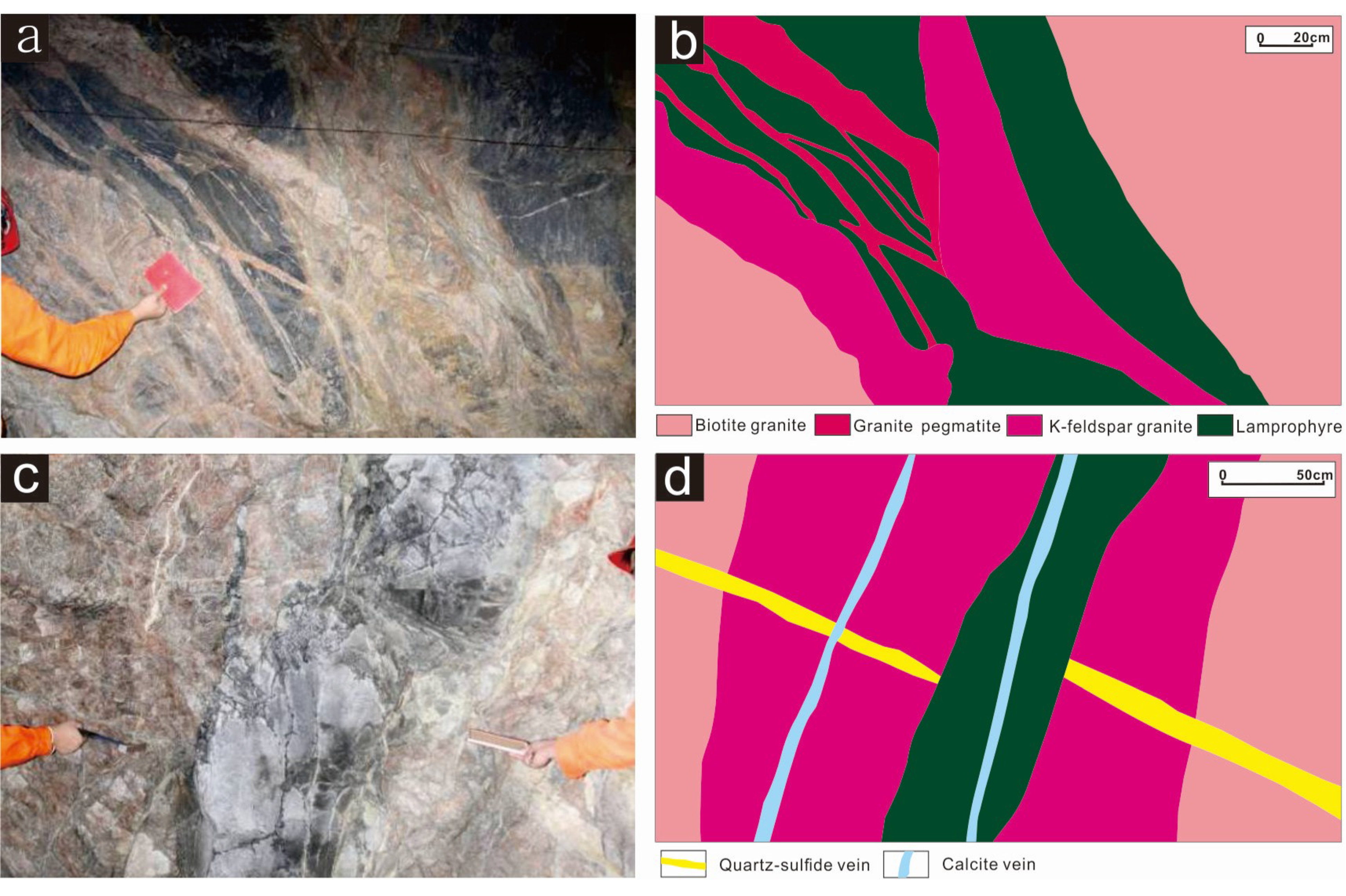
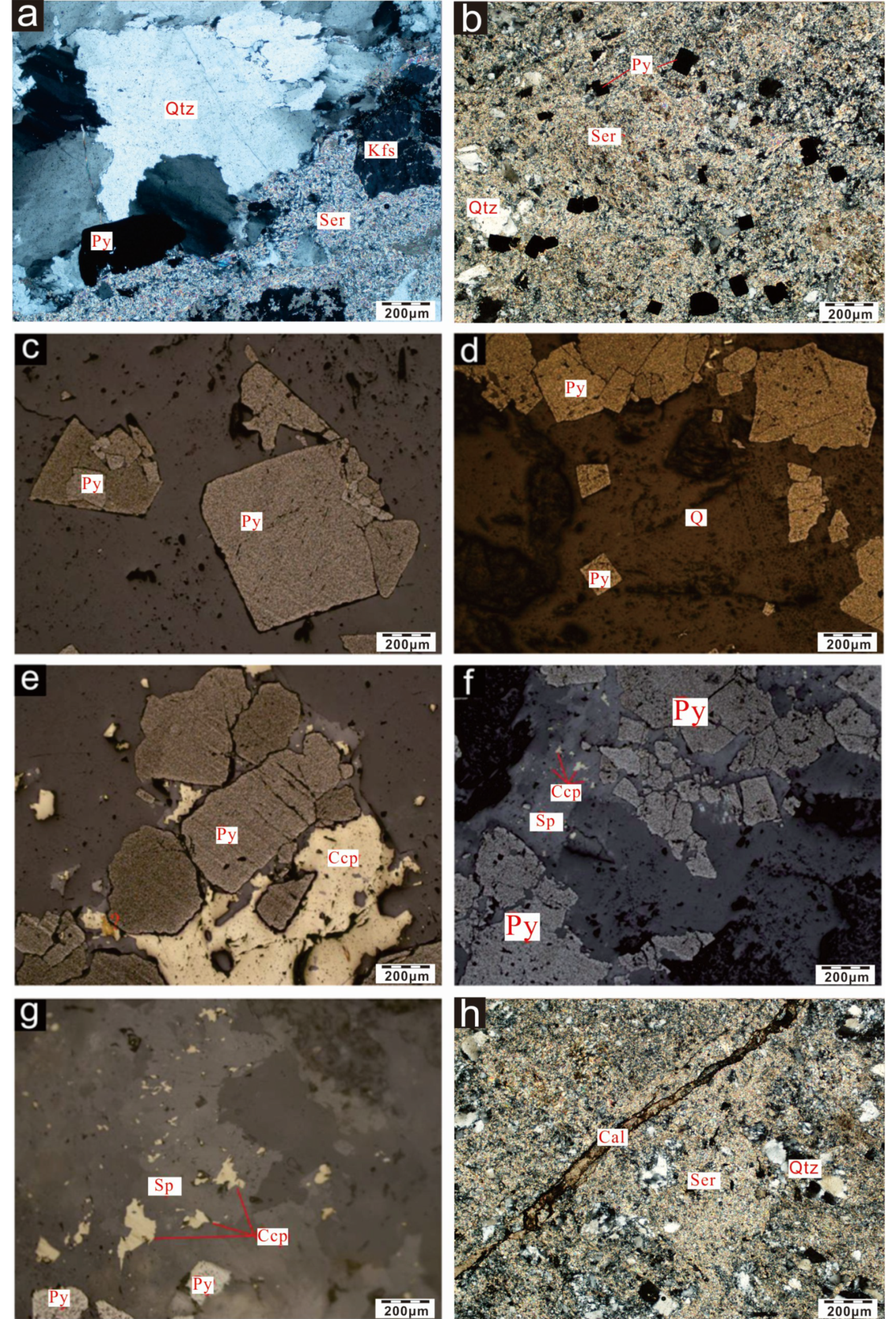
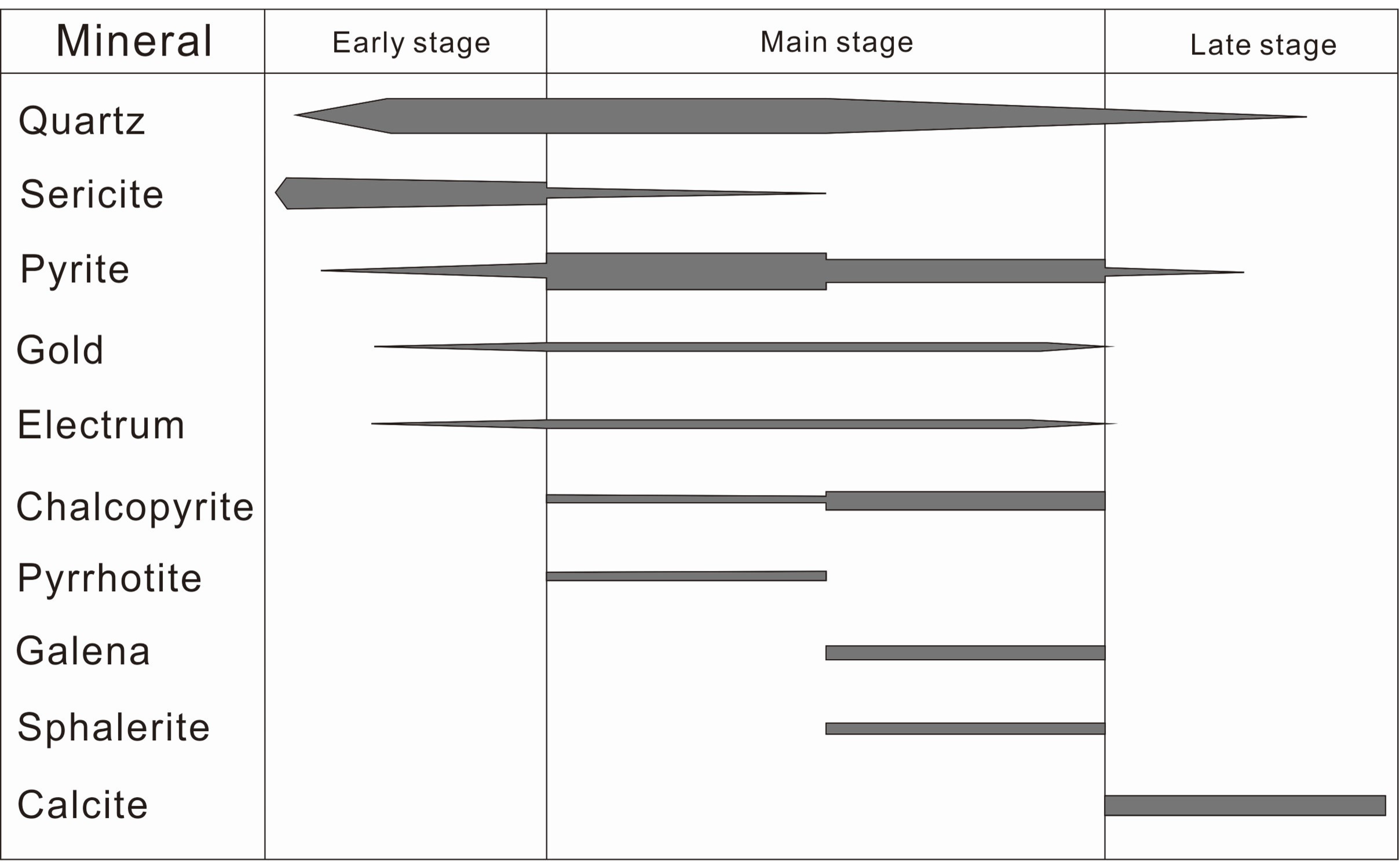
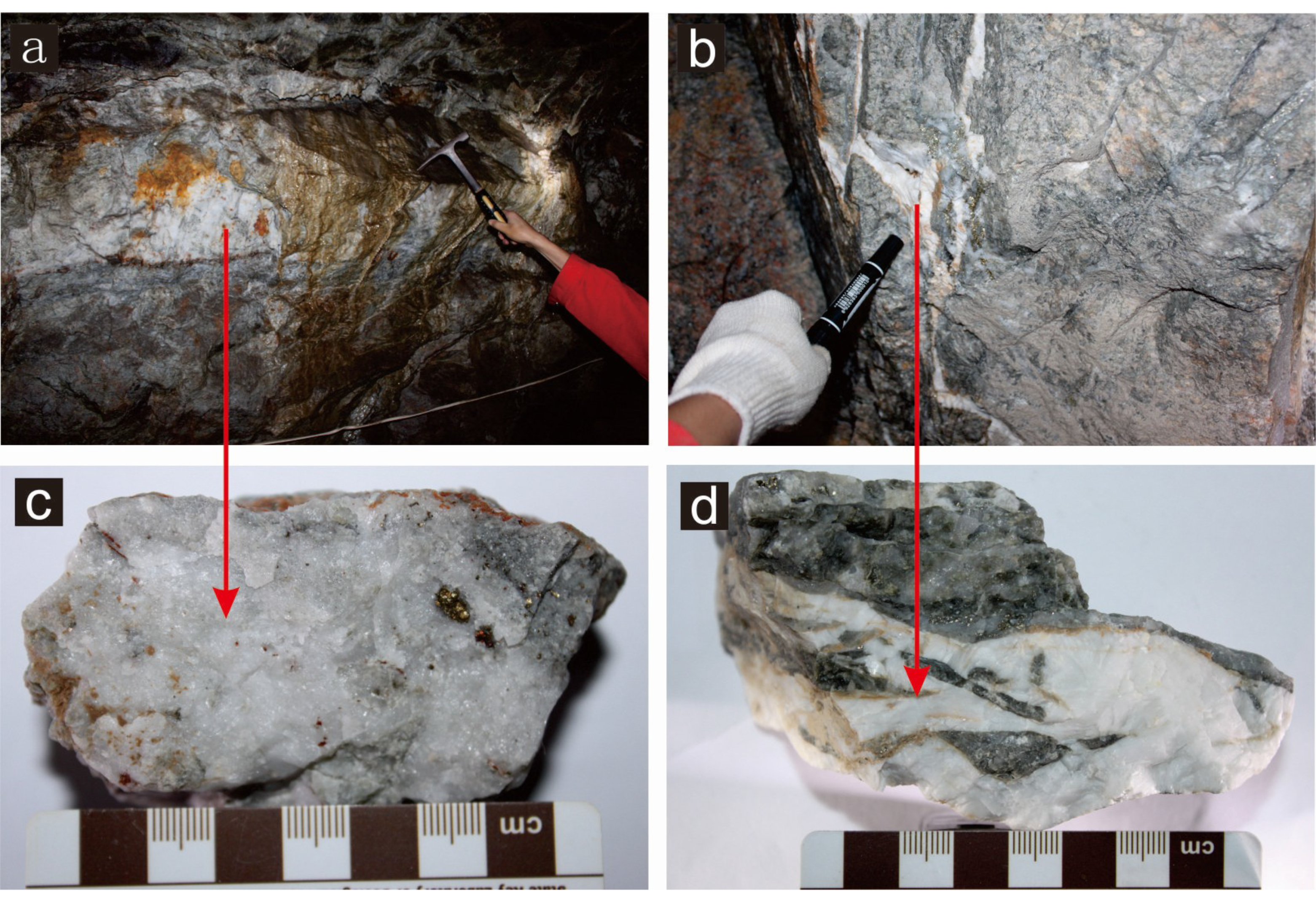
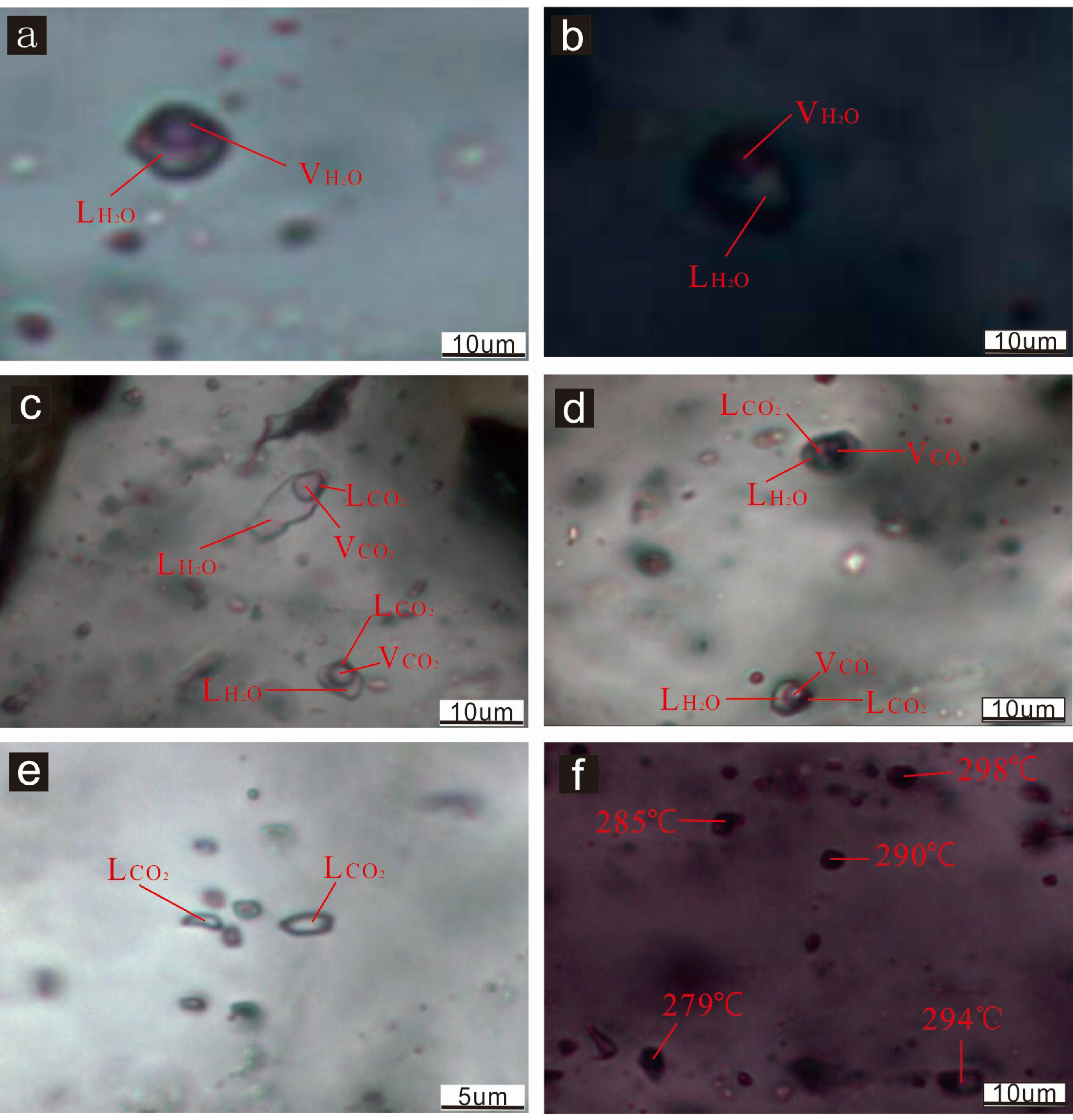
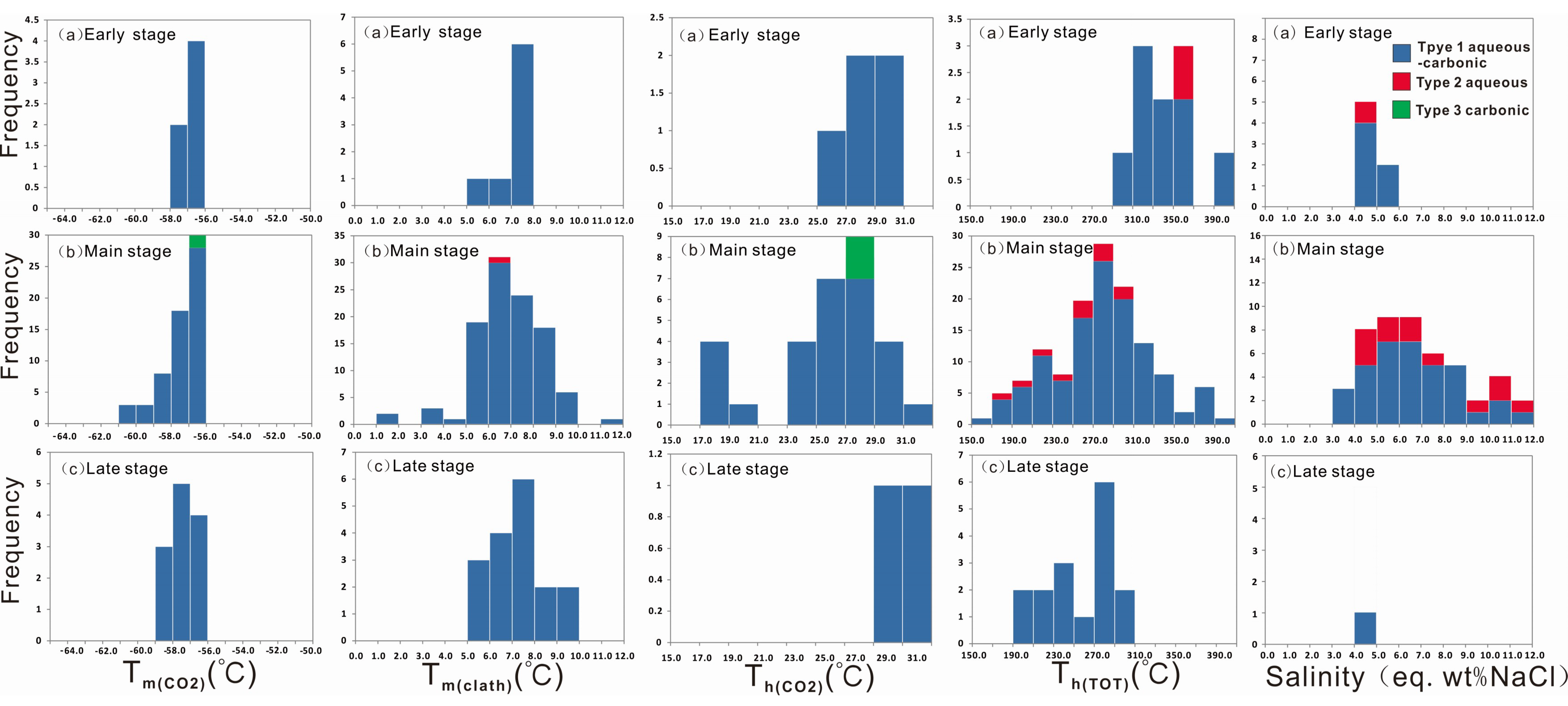
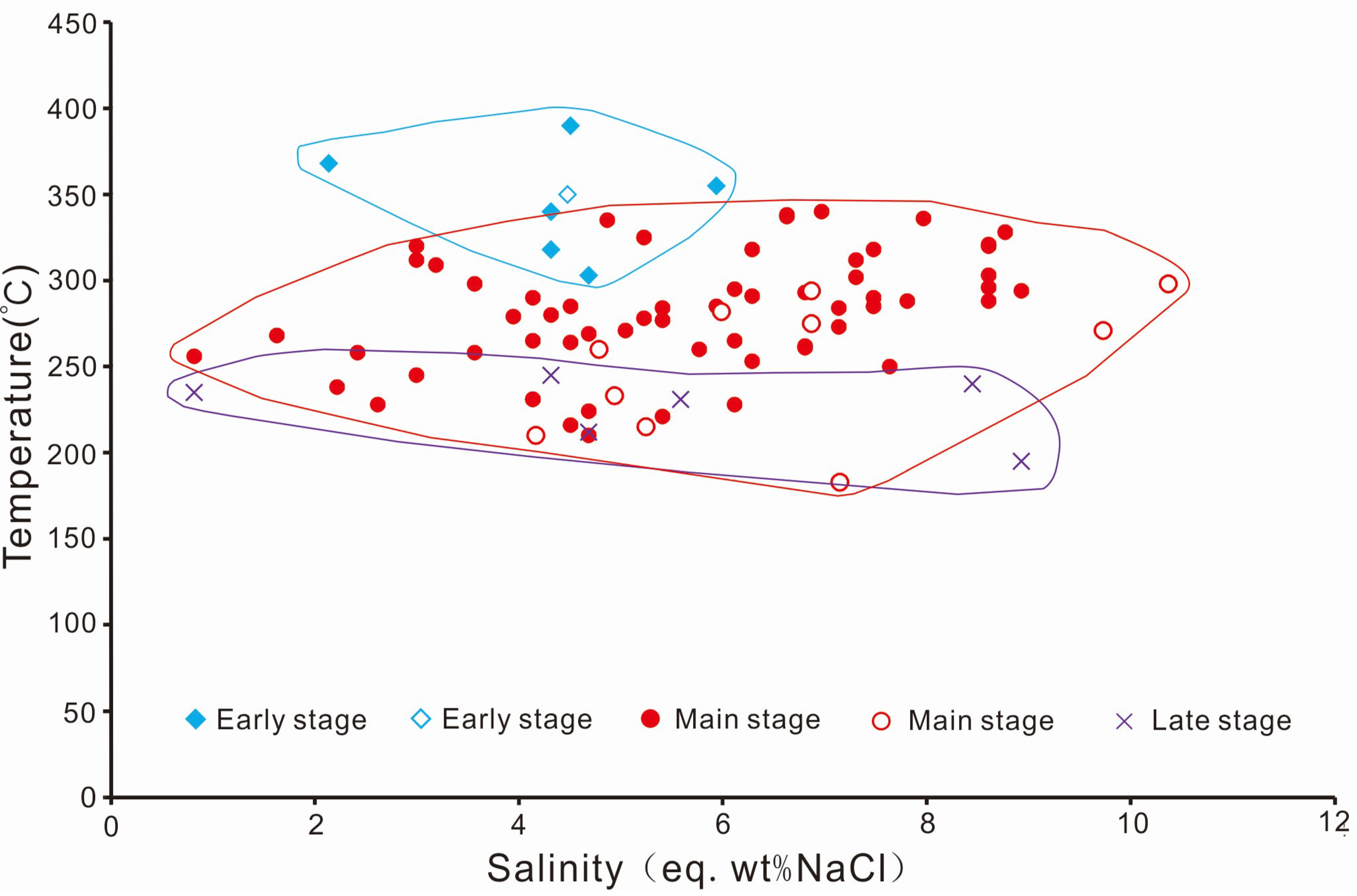
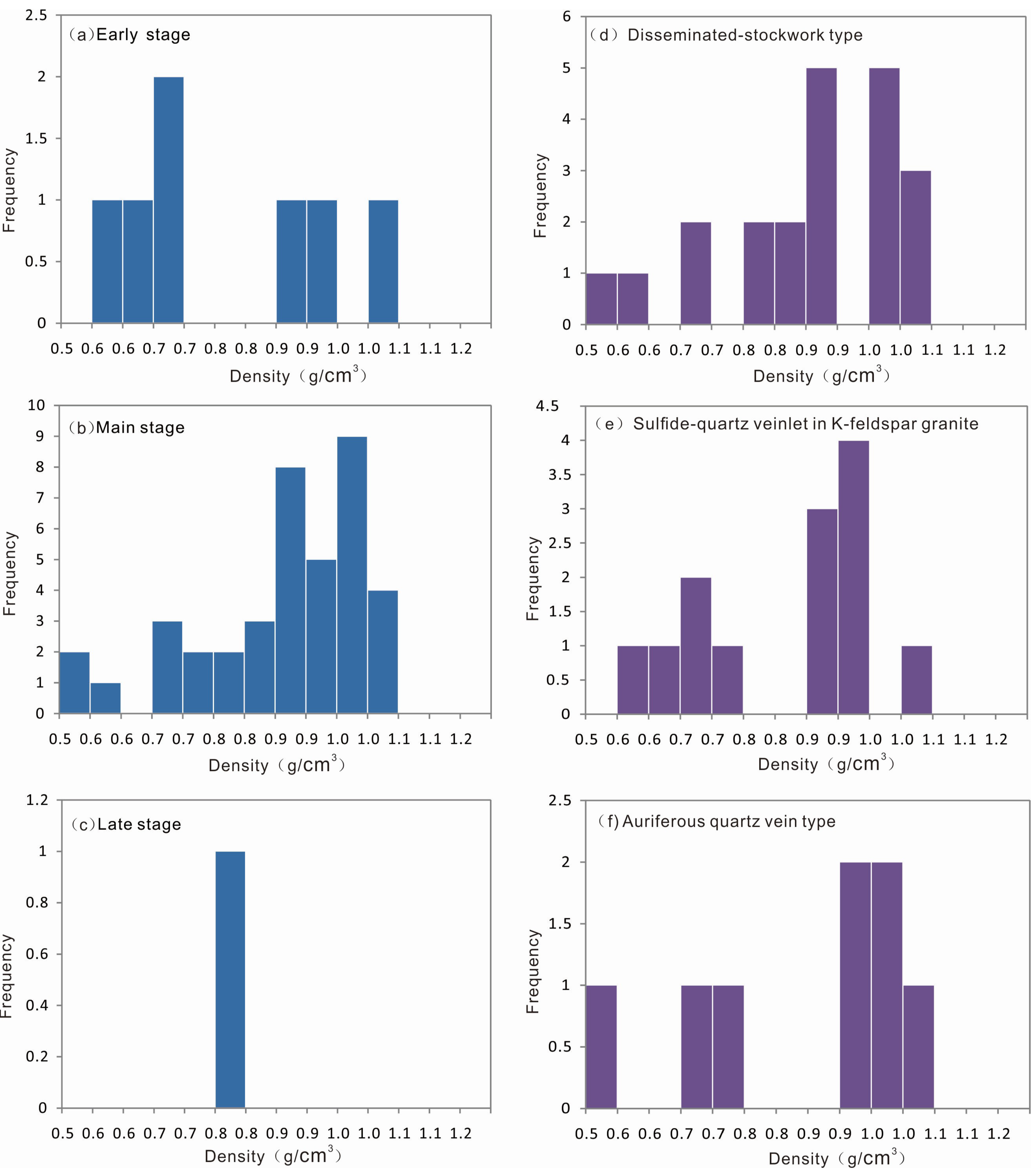
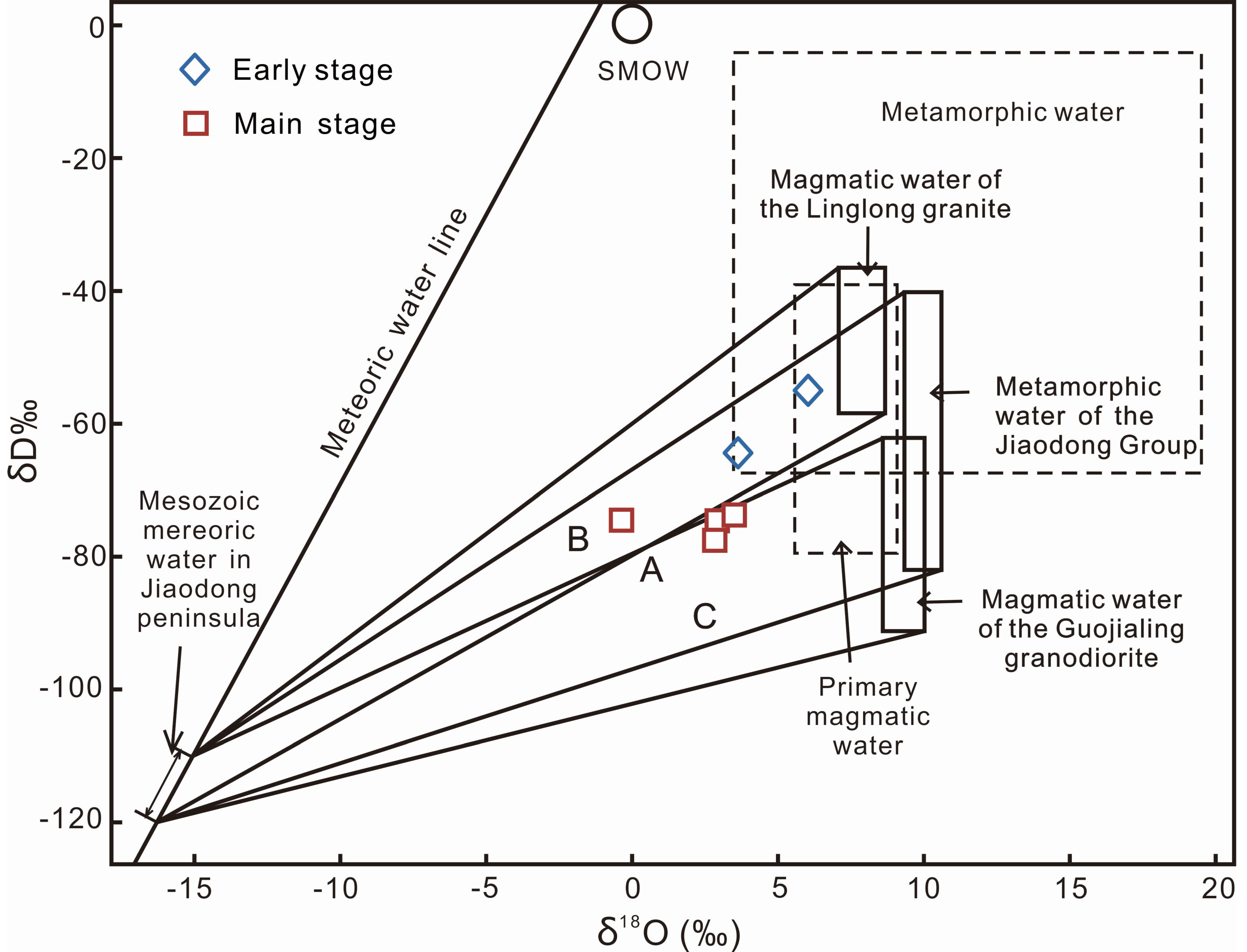
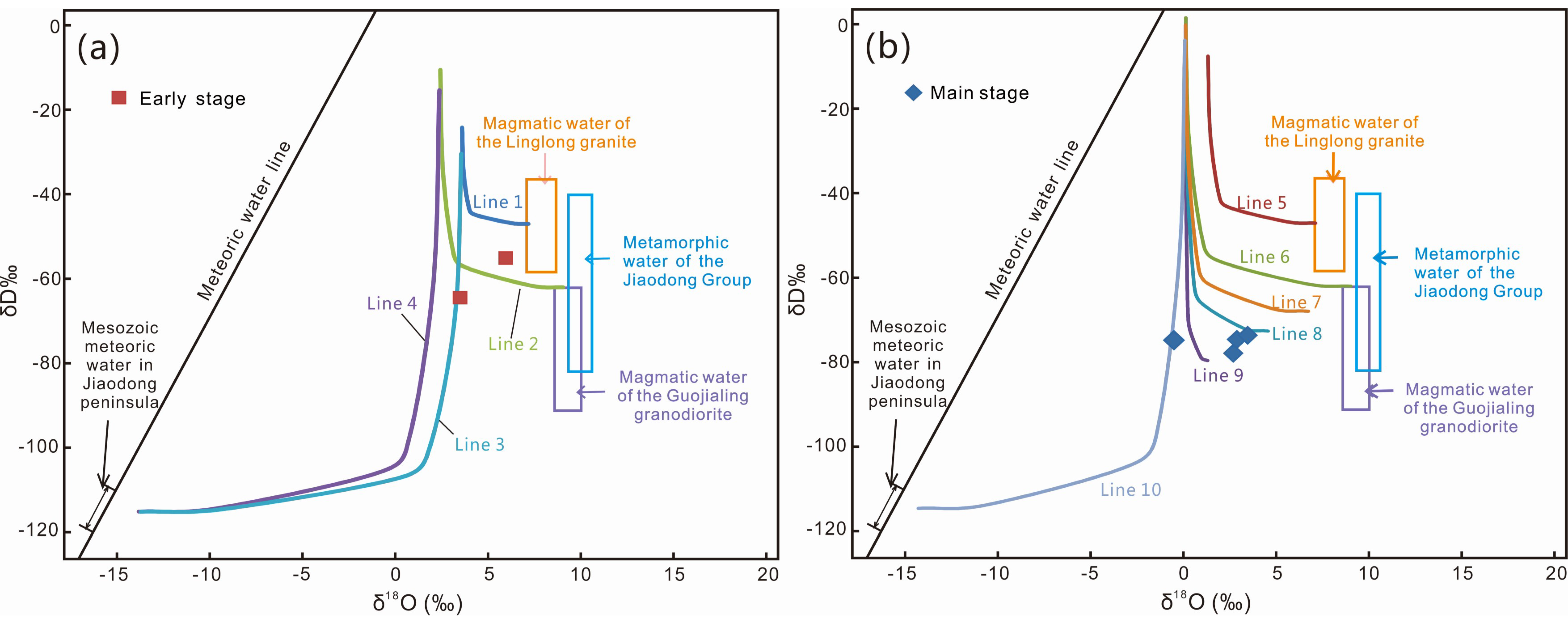
| Sample | Stage | Ore Style |
|---|---|---|
| SZ13D008B3 | early | Sulfide-quartz veinlet in K-feldspar granite |
| SZ13D008B2 | main | Sulfide-quartz veinlet in K-feldspar granite |
| SZ13D020B2 | main | Disseminated-stockwork style |
| SZ14D019B2 | main | Disseminated-stockwork style |
| SZ13D005B1 | main | Auriferous quartz vein style |
| SZ13D008B3 | main | Sulfide-quartz veinlet in K-feldspar granite |
| SZ14D016B1 | main | Auriferous quartz vein style |
| SZ14D020B4 | main | Disseminated-stockwork style |
| SZ14D017B2 | late | Calcite vein |
| Sample | Types | VCO2 (%) | TmCO2 (°C) | Tmice (°C) | Tmclath (°C) | ThCO2 (°C) | ThTOT (°C) | Salinity (wt %) |
|---|---|---|---|---|---|---|---|---|
| Early Stage SZ13D008B3 | type 1 | 20–50 (37, n = 8) | −57.5–−56.6 (−56.8, n = 5) | 5.2–7.9 (7.3, n = 7) | 26.9–29.5 (28.0, n = 5) | 303–368 (331, n = 6) | 4.14–8.77 (5.27, n = 6) | |
| type 2 | 20 | −2.7(n = 1) | 350(n = 1) | 4.48 | ||||
| Main Stage SZ13D008B2 | type 1 | 20–40 (33, n = 14) | −57–−56.6 (−56.9, n = 6) | 5.3–7.8 (6.6, n = 9) | 27.2–29.0 (26.9, n = 2) | 285–321 (299, n = 10) | 4.32–8.61 (6.38, n = 8) | |
| SZ13D020B2 | type 1 | 15–40 (28, n = 20) | −58.5–−57.2 (−57.6, n = 6) | 5.1–8.9 (7.5, n = 15) | 27.7 | 231–309 (272, n = 17) | 4.22–8.93 (5.64, n = 14) | |
| type 2 | 20–40 (43, n = 4) | −7–−6.9 (−7, n = 2) | 6.6 (n = 1) | 285–298 (292, n = 2) | 10.37–10.49 (10.43, n = 2) | |||
| SZ14D019B2 | type 1 | 15–35 (28, n = 10) | −60.5–−56.9 (−58.6, n = 3) | 5.1–6.5 (6.0, n = 3) | 24–25.8 (25.2, n = 3) | 296–332 (314, n = 7) | 6.63–8.93 (7.52, n = 3) | |
| type 2 | 20–30 (23, n = 5) | −4.3–−3.7 (4.1, n=3) | 251–294 (275, n = 4) | 5.99–6.87 (6.58, n = 3) | ||||
| type 3 | - | −56.6(n = 2) | 27.1(n = 2) | |||||
| SZ13D005B1 | type 1 | 20–45 (30, n = 18) | −59.8–−57 (−58.3, n = 8) | 3.4–11.2 (7.7, n = 14) | 17.8–28 (24.1, n = 3) | 264–290 (276, n = 7) | 4.32–11.43 (0.62, n = 7) | |
| SZ13D008B3 | type 1 | 5–35 (19, n = 7) | −56.9–−56.8 (−56.9, n = 2) | 6.1–8.4 (7.5, n = 4) | - | 224–275 (243, n = 6) | 4.14–7.31 (5.38, n = 4) | |
| type 2 | 20–30 (27, n = 4) | −8.1–−4.5 (−6.3, n = 3) | 270–271 (271, n = 2) | 7.15–11.83 (9.57, n = 3) | ||||
| SZ14D016B1 | type 1 | 20–40 (30, n = 17) | −59.5–−56.7 (57.5, n = 10) | 3.7–9.6 (6.8, n = 14) | 18.3–28.3 (25.4, n = 6) | 210–262 (232, n = 11) | 4.32–11.01 (7.75, n = 11) | |
| SZ14D020B4 | type 1 | 10–40 (36, n = 19) | −57.8–−56.5 (−57.1, n = 11) | 5.2–8.7 (6.7, n = 13) | 17.6–29.7 (25.0, n = 4) | 253–288 (266, n = 8) | 4.14–8.77 (7.18, n = 10) | |
| type 2 | 10–40 (28, n = 5) | −3.2–−2.5 (−2.9, n = 4) | 210–233 (219, n = 3) | 4.17–5.25 (4.79, n = 3) | ||||
| Late Stage SZ14D017B2 | type 1 | 10–30 (33, n = 19) | −58.3–−56.9 (57.6, n = 10) | 5–9.6 (7.1, n = 15) | 29.4–31 (30.2, n = 2) | 195–289 (240, n = 15) | 4.69–9.08 (7.18, n = 10) |
| Sample | Stage | δ18Oquaitz | Equilibrium Temperature | δ18OH2O | δDH2O |
|---|---|---|---|---|---|
| (‰) | (‰) | (‰) | |||
| 10SZ06 | Early stage | 10.3 | 320 | 3.6 | −64.3 |
| Z4974-5 | Early stage | 13.9 | 290 | 6.1 | −55 |
| 10SZ01 | Main stage | 13.4 | 230 | 2.9 | −74.7 |
| 10SZ31 | Main stage | 14.2 | 225 | 3.5 | −73.8 |
| 10SZ28 | Main stage | 12.5 | 245 | 2.8 | −77.7 |
| 10SZ32 | Main stage | 9.7 | 235 | −0.5 | −74.6 |
| Rocks/Fluid | δ18O (‰) | δD (‰) | Data Resources |
|---|---|---|---|
| Jiaodong Group metamorphic rocks | 8.2 ± 3.1 | −88.5 ± 7.5 | Chen, 1995 [49] |
| Linglong granite | 7 | −72 ± 11 | Lin and Yin, 1998 [50] and Mao et al., 2005 [51] |
| Guojialing granodiorite | 10.1 ± 0.4 | −102 ± 15 | Zhang et al., 1994 [52] and Mao et al., 2005 [51] |
| Metamorphic water of the Jiaodong Group | 9.9 ± 0.7 | −62 ± 21 | Zhang et al., 1994 [52] |
| Magmatic water of Linglong granite | 7.7 ± 1.0 | −47 ± 11 | Zhang et al., 1994 [52] |
| Magmatic water of Guojialing granite | 9.3 ± 0.8 | −77 ± 15 | Mao et al., 2005 [51] |
| meteoric water | −15.6 ± 0.6 | −115 ± 5 | Zhang et al., 1994 [52] |
© 2019 by the authors. Licensee MDPI, Basel, Switzerland. This article is an open access article distributed under the terms and conditions of the Creative Commons Attribution (CC BY) license (http://creativecommons.org/licenses/by/4.0/).
Share and Cite
Wei, Y.-J.; Yang, L.-Q.; Feng, J.-Q.; Wang, H.; Lv, G.-Y.; Li, W.-C.; Liu, S.-G. Ore-Fluid Evolution of the Sizhuang Orogenic Gold Deposit, Jiaodong Peninsula, China. Minerals 2019, 9, 190. https://doi.org/10.3390/min9030190
Wei Y-J, Yang L-Q, Feng J-Q, Wang H, Lv G-Y, Li W-C, Liu S-G. Ore-Fluid Evolution of the Sizhuang Orogenic Gold Deposit, Jiaodong Peninsula, China. Minerals. 2019; 9(3):190. https://doi.org/10.3390/min9030190
Chicago/Turabian StyleWei, Yu-Ji, Li-Qiang Yang, Jian-Qiu Feng, Hao Wang, Guang-Yao Lv, Wen-Chao Li, and Sheng-Guang Liu. 2019. "Ore-Fluid Evolution of the Sizhuang Orogenic Gold Deposit, Jiaodong Peninsula, China" Minerals 9, no. 3: 190. https://doi.org/10.3390/min9030190
APA StyleWei, Y.-J., Yang, L.-Q., Feng, J.-Q., Wang, H., Lv, G.-Y., Li, W.-C., & Liu, S.-G. (2019). Ore-Fluid Evolution of the Sizhuang Orogenic Gold Deposit, Jiaodong Peninsula, China. Minerals, 9(3), 190. https://doi.org/10.3390/min9030190





